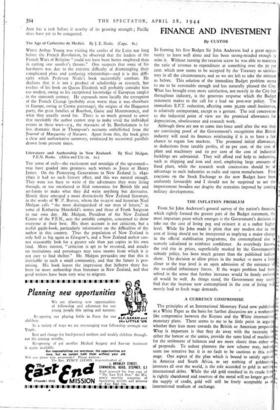FINANCE AND INVESTMENT
By CUSTOS
IN framing his first Budget Sir John Anderson had a great oppor- tunity to leave well alone and has been strong-minded enough to seize it. Without turning the taxation screw he was able to maintain the ratio of revenue to expenditure at something over the 5o per cent. which now seems to be accepted by the Treasury as satisfac.- tory in all the circumstances, and so we are left to take the mixture as before. This solution of the immediate Budget problem seems to me to be reasonable enough and has naturally pleased the City. What has brought even more satisfaction, not merely in the City but throughout industry, is the generous response which the Budget statement makes to the call for a lead on post-war policy. The immediate E.P.T. reduction, affecting some 30,000 small businesses, is relatively unimportant, except as a gesture. The real concessions to the industrial point of view are the promised allowances for depreciation, obsolescence and research work.
Although these are not to come into force until after the war they are convincing proof of the Government's recognition that British industry will need its finances reinforcing if it is to have a fair chance to regain lost markets. The promised initial allowances, as deductions from taxable profits, of zo per cent. of the cost of plant and machinery and so per cent of the cost of industrial buildings are substantial. They will afford real help to industries, such as shipping and iron and steel, employing large amounts of fixed plant, while the research work concess'ons should be of advantage to such industries as radio and rayon manufacture. First reactions on the Stock Exchange to the new Budget have been uniformly favourable and I should not be surprised to see the improvement broaden out despite the restraints imposed by coming t, military developments.
THE INFLATION PROBLEM From Sir John Anderson's general survey of the nation's financei, which rightly formed the greater part of the Budget statement, the most important point which emerges is the Government's decision t take out the cost of living peg and reinsert it at a rather high;- level. While Sir John made it plain that any modest rise in the cost of living should not be interpreted as implying a major change in the official stabilisation programme, the contemplated rise is scarcely calculated to reinforce confidence. As everybody knows, the real rise in prices, superficially masked by the Government's subsidy policy, has been much greater than the published indices show. The decision to allow prices in the market to move a little closer to the true level is an open admission of the existence of the so-called inflationary forces. If the wages problem had bee' solved in the sense that further increases would be firmly resist-' all would be well. As things stand, the Government may eastl find that the increase now contemplated in the cost of living w merely lead to fresh wage demands.
A CURRENCY COMPROMISE
The principles of an International Monetary Fund now publish as a White Paper as the basis for further discussion are a workman- like compromise between the Keynes and the White internation monetary plans. There seems to me to be little point in argui whether they lean more towards the British or American proposal What is important is that they do 'away with the necessity f' either the bancor or the unitas, provide the same kind of machine for the settlement of balances and are more elastic than either of proposals. To ardent planners the new scheme may, rode seem too tentative but it is no fault to be cautious at this earl stage. One aspect of the plan which is bound to satisfy opinia' in America and South Africa, to say nothing of goldmini' investors all over the world, is the role accorded to gold in settli international debts. While the old gold standard in its crude fo is rightly abandoned and reserves of the metal will no longer gov-. the supply of credit, gold will still be freely acceptable as international medium of exchange.
ai A
lit its
10 CI PI e


























 Previous page
Previous page